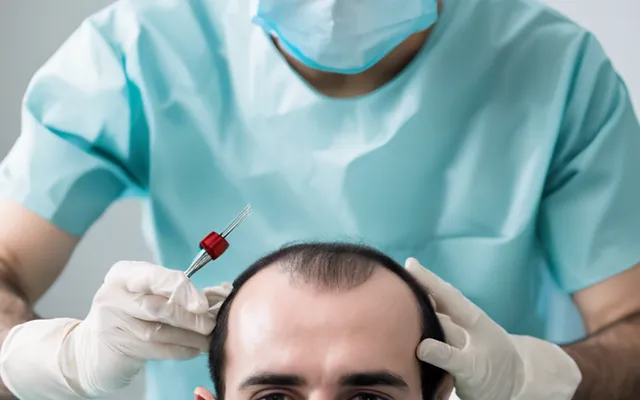The Role of AI in Revolutionizing Hair Transplants in the UK: How Technology is Shaping Hair Restoration

Hair transplants are no longer just a cutting-edge cosmetic procedure for the elite; they are becoming more accessible, advanced, and precise. This is largely due to the integration of artificial intelligence (AI) into the field. Over the last few years, AI has brought about significant changes in how hair transplants are performed, analyzed, and even recommended. This is especially true in the UK, where the medical and aesthetic industries are constantly pushing forward. As technology gets smarter, so do the options for hair restoration, and it’s changing the game in ways we couldn’t have imagined a decade ago.
The introduction of AI into hair transplant procedures is a huge leap, not only in terms of enhancing results but also in making the process smoother and more efficient for both patients and practitioners. So, let’s dive into how AI is advancing hair transplants and reshaping the future of hair restoration.
AI-Driven Diagnostics: Tailoring the Perfect Plan for Each Patient
One of the biggest ways AI has made its mark in hair transplants is by enhancing the diagnostic process. Before even getting to the surgery stage, AI can be used to analyze a patient’s scalp and hair condition with precision that wasn’t previously possible. Using sophisticated algorithms, AI systems can assess factors like scalp health, hair density, and hair growth patterns. Based on this analysis, doctors can tailor the most effective treatment plan for each individual.
For instance, AI-based scalp imaging tools can map out areas of the scalp that are thinning, and measure the rate of hair loss more accurately than the human eye ever could. These tools can even predict how a patient’s hair loss might progress in the future, which is crucial for planning long-term results. With this predictive ability, AI enables surgeons to design hairlines and transplant strategies that will look natural both today and in years to come.
Moreover, AI-driven diagnostic tools make it easier for practitioners to determine the right donor areas for hair extraction. By analyzing the density and quality of hair follicles, these systems can help surgeons harvest grafts that are more likely to thrive once transplanted, reducing the risk of poor results or failed grafts.
The Power of Precision: AI-Assisted Hair Transplant Robots
While hair transplants have traditionally been a very manual process, with surgeons painstakingly extracting and implanting individual follicles, AI is now lending a robotic hand to make this process faster, more accurate, and less invasive.
One of the most revolutionary advances in this space is the development of AI-assisted hair transplant robots. These robots are designed to assist surgeons in the extraction and implantation phases of a hair transplant. FUE (Follicular Unit Extraction), one of the most popular techniques for hair transplants, requires extracting individual hair follicles from the donor area and implanting them into the recipient area, follicle by follicle. This process, while effective, can be incredibly time-consuming and physically demanding for surgeons.
AI-enabled robots can automate part of this procedure by selecting and extracting hair follicles with high precision. These machines are able to identify the best grafts with minimal scarring and a faster recovery time for the patient. Because AI can work at a much quicker pace than a human, the procedure becomes shorter, reducing the time a patient spends under anesthesia and in surgery.
Additionally, AI-powered systems can ensure that the angle, depth, and placement of each graft are optimal, which results in a more natural look. Hair transplants in the UK performed by AI-assisted robots have the added benefit of producing consistent results, reducing the risk of human error. This combination of human expertise and AI precision has made hair transplants more efficient and effective than ever before.
Streamlining the Consultation Process with AI
Another area where AI is making a difference is in the consultation process. Clinics such as My Hair UK are increasingly offering online consultations powered by AI. These platforms allow patients to upload photos or videos of their scalp, which are then analyzed by AI software. The system can provide an instant, preliminary assessment of the patient’s hair loss condition to the trichologists and suggest potential treatments and graft numbers needed.
For busy professionals or those living in more remote areas, this means they can receive expert advice without needing to physically visit a clinic. Of course, in-person consultations are still necessary for the actual treatment, but AI can help streamline the initial stages, making it easier for patients to access professional guidance from the comfort of their homes.
In many ways, AI-based consultation tools are making the surgery more accessible by lowering the barriers to entry. Patients can get a clearer idea of what to expect before they commit to the procedure, and clinics can attract a broader audience by offering convenient, tech-powered consultations.
Post-Operative Monitoring: How AI is Enhancing Recovery
The benefits of AI in hair transplants don’t end once the procedure is completed. AI is also playing a vital role in post-operative care and monitoring, helping patients achieve the best possible results after surgery.
Traditionally, patients would need to return to the clinic for regular check-ups, which can be time-consuming and inconvenient. However, AI-driven platforms are now enabling remote monitoring, which allows doctors to keep an eye on the recovery process without the need for frequent in-person visits. Patients can take photos or videos of their scalp at home, and the system can assess healing progress, identify any complications early, and suggest next steps.
This not only helps patients feel more supported throughout the recovery process but also allows clinics to provide a higher level of care. For example, if the AI detects signs of infection or poor graft survival, the surgeon can intervene quickly to address the issue. It’s a proactive approach that leads to better outcomes and greater patient satisfaction.
AI and Personalized Hair Transplants: One Size Does Not Fit All
One of the most exciting things about AI in hair transplants is its potential for personalization. Hair loss is a deeply individual experience, and no two people’s hair loss patterns are exactly the same. AI is making it easier to customize hair transplant procedures based on each person’s unique needs, rather than relying on a one-size-fits-all approach.
For example, by analyzing data from previous patients, it can recommend the best treatment options for new patients with similar hair loss patterns. This type of data-driven personalization ensures that each patient receives the most effective treatment for their specific condition, whether that’s FUE, FUT (Follicular Unit Transplantation), or a combination of procedures.
AI is also helping to refine hairline design. A natural-looking hairline is one of the most critical elements of a successful hair transplant, and AI can help surgeons design hairlines that complement the patient’s facial structure, age, and hair growth patterns. This ensures that the final result looks not only natural but also harmonious with the patient’s overall appearance.
Affordability and Accessibility: Making Hair Transplants More Inclusive
As AI continues to improve the efficiency of hair transplants, it’s also driving down costs. Procedures that used to take eight or more hours can now be completed in less time, which means lower labor costs for clinics. Additionally, the precision offered by AI reduces the risk of complications or the need for follow-up procedures, saving both time and money for patients.
In the UK, where hair transplants were once seen as a luxury for the wealthy, AI is helping make these procedures more accessible to a broader audience. Many clinics are now offering more affordable hair transplant options without sacrificing quality, thanks to the efficiency gains provided by AI technology.
Moreover, the increased availability of AI-powered tools for diagnostics, consultations, and post-operative care means that hair transplants are becoming easier to access for people across the country, regardless of their location. Patients no longer need to travel to London or other major cities to receive world-class treatment, as more clinics are adopting AI to offer top-tier services nationwide.
The Future of AI in Hair Transplants
The integration of AI into transplants is still in its early stages, but the potential for future developments is immense. As AI continues to learn and improve, we can expect even more precise and efficient procedures, as well as new treatment options that haven’t yet been imagined.
For example, researchers are exploring the possibility of using AI to stimulate hair growth at the cellular level, potentially reducing the need for invasive surgeries altogether. In the future, it could even help develop hair cloning techniques, allowing patients to regenerate their own hair without the need for donor grafts.
The possibilities are endless, and the UK is poised to be at the forefront of these innovations. With AI leading the charge, hair transplants are becoming more accessible, affordable, and effective for people across the country.
AI is advancing the field of hair transplants in ways that were unimaginable just a few years ago. From AI-assisted robots to personalized treatment plans and remote monitoring, the integration of technology is making hair transplants more precise, efficient, and accessible. As more clinics in the UK adopt these innovations, we’re seeing a new era of hair restoration that offers better results with less hassle.
Spotted something? Got a story? Send a Facebook Message | A direct message on Twitter | Email: [email protected] Latest News








